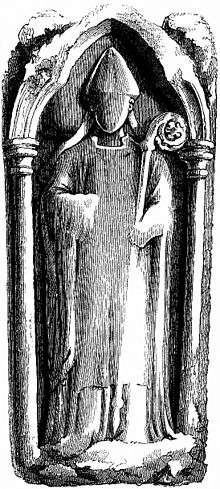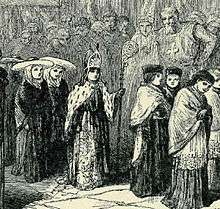Boy bishop
Boy bishop was a name given to a custom very widespread in the Middle Ages, whereby a boy was chosen, for example among cathedral choristers, to parody the real bishop, commonly on the feast of Holy Innocents. This custom was linked with others, such as that of the Feast of Fools and the Feast of Asses.

History

In England the boy bishop was elected on 6 December, the feast of Saint Nicholas, the patron of children, and his authority lasted till Holy Innocents' day (28 December).[1] The real Bishop would, symbolically, step down at the deposuit potentes de sede of the Magnificat ("he hath put down the mighty from their seat"), and the boy would take his seat at et exaltavit humiles ("and hath exalted the humble and meek").
After the election, the boy was dressed in full bishop's robes with mitre and crozier and, attended by comrades dressed as priests, made a circuit of the town blessing the people. Typically the chosen boy and his colleagues took possession of the cathedral and performed all the ceremonies and offices, except Mass. Originally, it seems, confined to the cathedrals, the custom spread to many parishes.[1]
Notwithstanding the intervention of various Church authorities (see Feast of Fools), the popularity of the custom made it resilient. In England it was abolished by Henry VIII in 1542, revived by Mary I in 1552 and finally abolished by Elizabeth I. On the continent of Europe it survived longest in Germany, in the so-called Gregoriusfest, said to have been founded by Gregory IV.[1] The custom has given rise to some popular misconceptions, however, one of which is the traditional misidentification of a miniature episcopal tomb effigy at Salisbury as a boy bishop: this is more likely to commemorate a secondary burial (heart or viscera) of a real bishop.
Revivals
There have been some recent revivals both in the English-speaking world and on the continent. Most famous perhaps is that of Hereford, revived in 1973 for a special children's service, with full and traditional ceremonies following annually since 1982. The Boy Bishop preaches a sermon and leads prayers at various Diocesan Advent services. A single revival took place in 1959 at St. George's Parish Church,[2] Stockport. Such ceremonies are now also found at Westminster Cathedral, Salisbury Cathedral, and a number of parish churches throughout England, including All Saints' Church, Northampton, Claines, Worcestershire, and also St Christopher's Parish Church, Bournemouth, (early 1950s), where the Boy Bishop was installed on St Christopher's Day, (July 25), and 'reigned' for one year, preaching and 'presiding' at youth events. The market town of Alcester, Warwickshire has its very own St Nicholas night complete with the Boy Bishop on 6 December each year.
The custom was likewise revived in Burgos, Spain, where the boy-bishop feast had been extremely popular before the cathedral choir was closed in the 1930s. After its re-establishment, the boy bishop was revived in 1987, and has since been celebrated every year.[3] Other Spanish cities such as Palencia also hold the ceremony,[4] and that carried on in the Monastery of Montserrat by L'Escolania is especially renowned.[5] The festival was also revived in Chavagnes International College, a Catholic boarding school in France.
In the United States, one of the first adoptions of the custom took place in 1979 at the Cathedral of All Saints (Episcopal) in Albany, New York, as part of an annual medieval fair held in the great Gothic-revival style church.
In December 2009, a teenage girl from Wellingborough England was appointed Britain's first girl bishop at All Saints Church in the town.[6]
Further reading
Recent works
- A. Ward, "Richard Ramsey's Sermon for a Boy Bishop (Tudor Catholic Sermons 2)", in Ephemerides Liturgicae 111 (1997) 476-505.
- A. Ward, "A Sermon for A Boy Bishop by John Alcock, Bishop of Ely (1430-1486-1500)", in Ephemerides Liturgicae 112 (1998) 58-81.
- N. Mackenzie, The Medieval Boy Bishops, 2012.
Less recent
- John Gough Nichols (ed.), "Two Sermons pronounced by the Boy Bishop at St. Paul's, Temp. Henry VIII, and at Gloucester, Temp. Mary", in Camden Miscellany, Volume the Seventh, Camden Society, 1875.
- W.C. Meller, The Boy Bishop and other Essays on Forgotten Customs and Beliefs of the Past, London 1923, pp. 3–18
- A. Gastá‚ "Les Drames liturgiques de la cathédrale de Rouen", in Revue catholique de Normandie 2 (1893) 349-372, 477-500, 573-605.
- T.H.V. Motter, The School Drama in England, London 1929, pp. 6–8, 11-12, 31, 33, 49-50, 229, 252.
- J.P.W. Crawford, "A Note on the Boy Bishop in Spain", in Romanic Review 12 (1921) 146-154.
- Madeleine Charles, "Le drame liturgique", in La Vie et les arts liturgique 3 (1916–1917) 65-70, 121-134, 169-181, 258-266, 297-307, 403-412, esp. 404-406
- J. M. J. Fletcher, The Boy Bishop at Salisbury and Elsewhere, Salisbury [1921]
Classic works on religious and liturgical drama
- C.M. Gayley, Plays of our Forefathers, New York, 1907, pp. 54–61.
- E.K. Chambers, The Medieval Stage, 1903, vol. 1, pp. 336–371.
- R.B. Donovan, The Liturgical Drama in Medieval Spain, 1958.
- H. Craig, English Religious Drama of the Middle Ages, 1955.
- F. Arens (ed.) Der Liber Ordinarius der Essener Stiftskirche, Paderborn, 1908, p. 213.
- J.P.W. Crawford, Spanish Drama before Lope de Vega, Philadelphia 1922 (= Publications of the University of Philadelphia, Extra Series in Languages and Literatures 7), pp. 15–16.
- V. De Bartholomaeis, Le Origini della Poesia drammatica italiana, Bologna [1924], pp. 201–211
References
-

- Archived March 24, 2008, at the Wayback Machine
- Validivieso Arce, Jaime L. (1998). «La antigua fiesta infantil del Obispillo en Burgos». Revista de Folklore (Fundación Joaquín Díaz. Caja España) 18b (212): pp. 58-62.
- "El "Obispillo" de Palencia, el más antiguo de España, recupera su tradición - Público.es". Publico.es. 28 December 2009. Retrieved 1 April 2012.
- Kamen, Henry (1998). Cambio cultural en la sociedad del Siglo de Oro: Cataluña y Castilla, siglos XVI-XVII. Traducido por Paloma Sánchez del Moral. Siglo XXI de España Editores. pp. 91-92. ISBN 978-84-323-0969-4
- "New Eve for church as child is made 'bishop'". morthantstelegraph.co.uk. 7 December 2009.

External links
| Wikimedia Commons has media related to Boy bishop. |